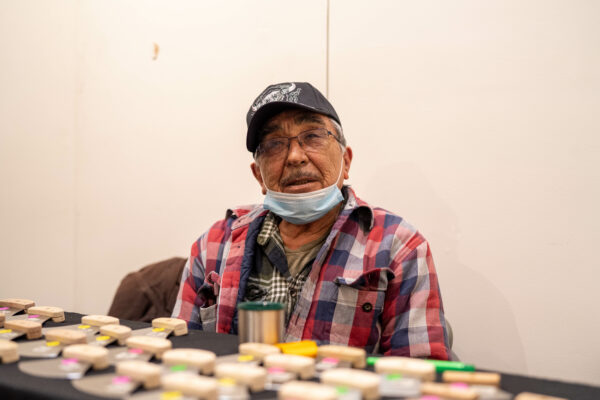
Yup’ik dance performances headlined the Cama-i Dance Festival in Bethel. But just off stage, dozens of artists and craftspeople from around Western Alaska showed off handmade work for sale, from carved ivory earrings and beadwork to colorful kuspuks and beaver skin hats.
Tununak artist John Oscar sold out of his mixed-media collage pieces on the festival’s first day.
“It’s been a very successful day,” he said.
Oscar, who lives in Bethel, combines materials like driftwood, feathers and ivory with acrylic paints to depict stories or scenes in nature.
His table was wedged into a corner of Bethel’s Yupiit Piciryarait Cultural Center. Dozens of other tables were packed in around his, showcasing handmade crafts from all over the Yukon-Kuskokwim Delta.
Oscar has been coming to Cama’i since the ‘90s. Not having the festival the last few years due to COVID-19 was tough on vendors like Oscar, especially as the pandemic made it more difficult to get materials.
Vendors said this year’s return to Cama-i was about more than just sales. It’s a relief.
“It feels like a breath of fresh air,” laughed Ida Alexie, who sat with her husband Roy Alexie behind a table covered with pine- and oak-handled ulus Roy made out hand saw blades. He’s been making the curved-blade knives for almost 50 years.
The first day of the festival, Ida said they sold half the ulus they brought. She was hopeful they’d sell the other half on day two.
“We missed having Cama-i,” she said as Roy nodded in agreement. “Because it’s a good moneymaker.”

There have been fewer opportunities to make that money since the pandemic started.
Many of Cama’i’s artisans sell at local Saturday Markets in Bethel or at venues in Anchorage to keep income flowing. Jonathan McIntyre is an ivory carver from Eek, but lives in Bethel. He sells at the Dimond Center in Anchorage sometimes, but his sales are better in Bethel.
“The people know me,” McIntyre said. “They rush coming in, coming to see me. It’s good to see a lot more people now.”
Every inch of McIntyre’s table was laden with pairs of carved ivory earrings, decorated with baleen and beads. He said he wasn’t sure if Cama-i would come back this year, but he carved all winter anyway, hoping he’d have a chance to sell his work at the festival.
McIntyre said he can make about 30 pairs of earrings in a week, using a hand saw with a metal-cutting blade, and templates he inherited from his grandfather. He learned to carve from watching his father and grandfather when he was a child.
“I was always in the shop, the garage … I look up to the older generation. That’s who I watch,” he said.
McIntyre said getting to keep his family’s craft alive makes him feel like a provider. He’s started to teach his nephews and his children to carve, too.

Around the corner, Helen Lane was also working to keep tradition alive. Lane, who was born in Point Hope, helped launch an Alaska Native women’s sewing shop called IñuPiphany in Anchorage last November.
“A lot of them haven’t sewn before. And so this is just a way for them to come and learn and heal. It’s a cultural healing center,” she said.
The Native women who attend make one piece for themselves and one for the shop. Then IñuPiphany sells the second piece to purchase more materials. Lane’s helped sell some of that work at Cama-i — caribou skin masks, fur gloves and hats, and a toddler-sized parka lined her table.
She said Cama-i provides a healing space for artists to carry on their traditions.
“You get to see different cultures, different villages do their dancing. And then they have their doors open for other artists to sell, because a lot of them, they rely on their art sales for providing for their families,” Lane said.
This year was Lane’s first time at Cama-i. Already, she said, sales were strong.
RELATED: Chefornak dancers honor loved ones at this year’s Cama-i Dance Festival
Kavitha George is Alaska Public Media’s climate change reporter. Reach her at kgeorge@alaskapublic.org. Read more about Kavitha here.





